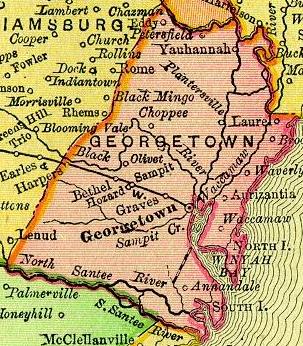 |
| |
Welcome to Georgetown County...
What
is present-day Georgetown County was
first settled by colonists in the
1720s. The town of Georgetown was
established in 1729 with the
official port following in 1732.
During this early period, Georgetown
was part of Craven County, which was
further divided into parishes by the
Parish Act of 1706. The first parish
established for this area was Prince
George's, Winyah Parish, established
in 1721, probably indicating the
earliest point in time that
significant numbers of settlers
began to find their way into the
area from points further south.
In 1734, the western half of
present-day Georgetown County became
part of the newly developed Prince
Frederick's Parish, which included
that half of present Georgetown
County as well as most of
present-day Williamsburg, Marion,
and Florence Counties. In 1767, All
Saints Parish was established, and
this parish included the coastal
part of present-day Georgetown
County and the coastal half of
present-day Horry County.
In 1768, the District Act created
the Georgetown District, which
included all of present-day
Georgetown, Horry, Marion, Dillon,
and most of Florence Counties. This
law was repealed by the British
Parliament, but a second Act was
soon approved in 1769. Right after
the American Revolution, this large
Georgetown District was divided into
four smaller districts: Winyah
(which was renamed Georgetown
District in 1800 and whose
boundaries are the same today as
Georgetown County); Liberty (which
was renamed Marion District in
1798), Kingston (which was renamed
Horry District in 1801), and
Williamsburg (which essentially
remained the same, with minor
changes in boundaries, to this day).
The Spanish were the first Europeans
to visit present-day Georgetown
County. In 1526, Lucas Vasquez de
Ayllon came to establish a colony in
the New World. In what he described
as latitude 33 degrees and 40
minutes, he entered a large river
which he named the Rio Jordan,
evidence of the first discovery of
the Cape Fear River. De Ayllon did
not settle along the Cape Fear, but
went further south to Winyah Bay,
almost exactly where the town of
Georgetown was established much
later in 1729. De Ayllon abandoned
this settlement soon after landing,
however, never to return to the
area. He went on to settle along the
Georgia coast, where he was killed
in 1526 by unfriendly natives.
The War of Jenkins Ear, a war of
vanity between England and the
French, Portuguese, and Spanish
traders left England without a
source of the coveted Royal Blue
Indigo dye. As the indigo plant grew
wild all along the coastal plains,
it was a natural transition for the
cleared land to be used for
cultivating indigo. Indigo is the
rarest of dyes, because blue is the
most difficult color to produce in a
dye.
